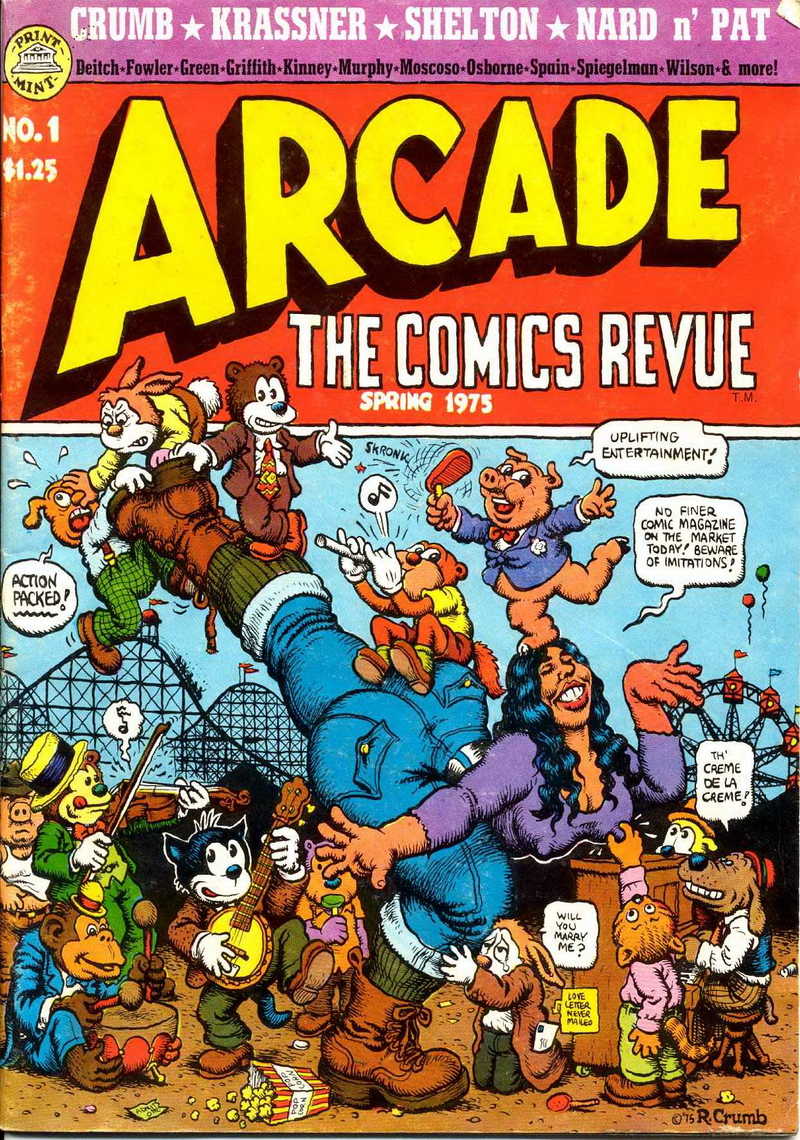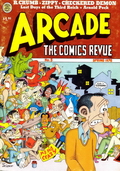arcade

arcade
Print Mint 1975-76
Art Spiegelman’s and Bill Griffith’s Arcade comic anthology series is considered by some to be the last stand in the era of underground comics. It is also considered by some to be the most ambitious and accomplished comic book series in the history of comic books. I am a bit of a contrarian on both points, quite honestly. Arcade, The Comics Revue was truly an ambitious undertaking, launched in 1975 out of Berkeley, California by co-editors Art Spiegelman and Bill Griffith. It was conceived as a “comics magazine for adults” that would showcase the “best of the old and the best of the new comics.” But ultimately, it failed to connect with a large audience, which I believe was due to the magazine being just too smart for its own good. As for representing the “last stand” of underground comics, I don’t think Arcade was representative of the spirit of underground comics in the first place, so its demise could not mark the era’s last stand.
Don’t get me wrong, Arcade was indeed a courageous attempt to bring intellectual comics to the masses, and my admiration for the effort is shared by many other comic experts and historians. Alan Moore said it was “the only truly worthwhile material produced during the 1970s.” But in my book, the name of the game in comics is entertainment, and on that count I believe that Arcade was weaker than another ambitious magazine series that followed a few years later; Weirdo. The first issue of Arcade, with its stunning Crumb cover, is beautiful to look at and lavishly illustrated throughout. Yet somehow the writing seems not quite right, almost as if everyone was trying too hard.
Subsequent issues only compounded the problem when the highlights could not make up for the lowlights. I’m sorry, I’m just not that keen on seeing Spain Rodriguez illustrate a biography of Joseph Stalin. And I hate to see Kim Deitch waste four pages of his talent on the life of Don Carlos Balmori. I love Henri Rousseau more than most people, but “A Couch in the Sun” is four dreary pages. “The Calvin Coolidge Story”? “Gotterdammerung” (a serious story about Adolf Hitler and the Nazis)? Not that these stories couldn’t have worked in the comics medium, but they don’t. Ironically, all of the people featured in these stories are fascinating figures in history; yet Arcade somehow made them seem dull.
The good news is that Arcade did deliver plenty of terrific stories and showcased the work of the most important creators from underground’s golden age, including Crumb, Griffith, Spiegelman, Wilson, Rodriguez, Williams, Deitch, Green, and Kominsky. It is justly lauded for refusing to pander to the lowest common denominator, even if that refusal helped lead to its going out of business. It was truly a shame that it did. Because every issue of Arcade remains an interesting read and challenges the reader to engage with its weighty content. In fact, I believe that the last couple issues of Arcade struck a fine balance between entertainment and education, and who knows what might have been if the series had continued.
Arcade is essential reading for underground comics collectors. I think it’s a great comic magazine, but it might also be just a bit overrated given all its accolades. To me, it isn’t the finest example of underground comics doing what they do best: challenging the status quo and expanding the scope and relevance of comic books in a bold and entertaining way. Arcade is a very good example of that. Just not the finest.

 01 action packed
01 action packed 02 modern america
02 modern america 03 sheer poetry
03 sheer poetry 04 frosty
04 frosty 05 hitler skitler
05 hitler skitler 06 bearzy wearzies
06 bearzy wearzies 07 dwarf clown
07 dwarf clown